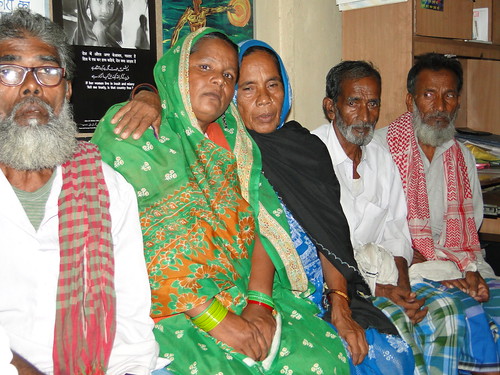By Nadim Asrar,
Bihar, in a new, resurgent India, is often presented as a case study of what a positive politics of development and inclusive growth can yield. While there are no actual figures to indicate the great turnaround that the state is credited with, the mere fact that a man can register one of the most charismatic election victories in recent times by merely building roads says a lot about Bihar’s condition today.
In fact, the aura around Nitish and his brand of ‘no-nonsense’ politics was so alluring that even the Gandhian crusader Anna Hazare succumbed to it when he said that Bihar and Gujarat are the two models that the UPA government at the centre should follow.
Although Anna later retracted the statement after his ‘civil society’ friends objected to him endorsing the man in Gujarat who once presided over the killing of more than 2000 Muslims, in hindsight it appears that it was a revealing statement.

Waiting for justice- Victims of the Forbesganj police firing at ANHAD office
Nitish Kumar, on the other hand, might have felt offended at being bracketed with the Hindutva icon in Anna’s hurried eulogy, especially after he did not allow Modi to enter Bihar during the campaigning. In his firm refusal to not to be seen with the Hindutva icon in the state lied Nitish’s desire to offset the dangers of his party, the JD(U), allying with the right-wing BJP.
The Muslims also responded in an unprecedented manner. Tired of the vote-bank politics played by the likes of Lalu Prasad Yadav and Ramvilas Paswan, unsure of a more centrist Congress making any headway in Bihar, and perhaps having fallen for the idea of a New India, the 17 percent Muslim electorate in the state bought the Nitish brand of politics and rallied behind him. Sadly enough, it didn’t take long for the illusion to present itself in a violent manner.
After what happened on June 3 in Forbesganj, it seems that Anna Hazare was able to see what even the best political observers of the country were not able to: that there does exist a tragic similarity between Bihar and Gujarat. If Nitish didn’t allow Narendra Modi to enter Bihar, he knew he had another Modi in his camp (and the Cabinet) to bank upon. Deputy CM Sushil Kumar Modi, though less flamboyant than his party colleague in Gujarat, nevertheless belongs to the same stripes.
Reports indicate that the man whose factory created the problems in the area is a close associate of Modi. It is also understood that the Bihar police carried out the killings and violence under direct orders from the Deputy CM’s office.
I know it’s a stretch to make sweeping comparisons between Gujarat and Bihar, especially after the fact that the pogrom of 2002 still prevents Narendra Modi from seeking a larger role in the national political mainstream. The blot of Gujarat continues to haunt the BJP and even scare its allies, who, despite continuing with the right-wing party, openly slam Gujarat 2002.
Yet, in essence, the June 3 incident, in which five unarmed villagers were killed by the Bihar police, is comparable. Here again the state machinery was involved in the killing, and, by a coincidence obviously not unknown to the perpetrators of violence in Forbesganj, all the Forbesganj victims happen to be Muslims. Reports say that the BJP leader, who owned the factory against which the protest was organized, too joined the police in firing at the villagers. Among the dead are a pregnant woman and a five-month-old infant.
Police and post-mortem reports show that the firing was done with an intention to kill. Wounds on the dead and the injured are mostly on the neck, chest and the upper torso. Those who survived to tell the story add that the cops chased the unarmed villagers to their huts and that most of the firing was from point-blank range.
A grainy video shot by a local reporter shows a policeman jumping over the dead and injured bodies while his colleagues watch. The stomping of the dead by police is a revealing metaphor for the contemporary times. We have seen that in Chhattisgarh, Maharashtra and Orissa.
In a country violently obsessed with touching the double-digit growth figures, any opposition to what the state defines as ‘development’ and ‘public interest’ deserves nothing less than guns. What is worse is that the guns that safeguard state/corporate interests also enjoy impunity from media and the courts — institutions considered as guardians of the constitution.
That explains why so much of attention and media space can be given to an anti-corruption campaign, but not to an open and non-violent debate over the competing visions of development and statehood. That explains why while ‘middle-class’ killings like Aarushi’s or Jessica Lall’s succeed in getting the mainstream media’s attention and not the ones in the remote areas of the nation.
The killers of Aarushi or Jessica Lall violate the social contract while incidents like Forbesganj only reinforce it. In a country dying for a place in the many Forbes’ lists, Forbesganj tragically remains an insignificant aberration.
————–
The author is Editor, News Features, IBNLive.com. He can be reached at [email protected]
